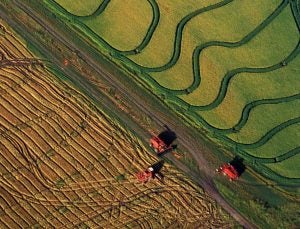Did you know that brown rice and white rice actually come from the same plant? When I heard this, I started wondering: What makes them different? Are they harvested at different times? If they come from the same plant, does that mean they’re nutritionally equivalent?
To find the answers, I reached out to Matthew Sligar, is a third-generation rice farmer in Northern California who farms 1,600 acres of medium grain CalRose rice with his father. This type of rice has earned awards for some of the best in the world, and the Sligars produce 16 million pounds of rice per year! He runs a YouTube channel and social media platform called “Rice Farming TV,” where he explains the process:
In short, brown and white rice are the same grain, just milled differently. Brown rice still has the bran. They’re both harvested at the same time, but if you remove the bran, you have white rice.
So, is brown rice more nutritious? The short answer is yes. From removing the hull to the bran down to the white rice itself, you are removing between 60 to 90 percent of the nutrients.
So why remove nutrients to get to white rice? Well, white rice has a longer shelf life and can practically last forever if properly sealed. The bran on brown rice does contain all the nutrients, minerals and oil, but those oils cause it to spoil quicker. Despite the fact that the milling process takes more time to produce the finished product, the brown rice tends to be more expensive because it does contain those nutrients, so people will pay a premium for that.
From a flavor and usefulness standpoint, both types of rice have their advantages though. If eating a healthier meal, such as grilled salmon, brown rice pairs perfectly with that and some vegetables. On the other hand it doesn’t stick together as well, so could you imagine having sushi constantly fall apart on you?
This is where white rice comes into play perfectly. It’s “stickier,” so it’s great for sushi, is milder in flavor and texture, tends to be cheaper, and is very versatile for Indian- or Asian-inspired dishes. It all depends on what you’re looking for but no doubt, rice is one of the most affordable and most oftenly consumed foods in the world. Fun fact? Virtually all rice used in sushi restaurants across the U.S. is grown in California. In this region, it’s usually planted in April, and harvest begins in September. Rice is grown in a number of states, though, with Arkansas reigning as the nation’s leader.

After harvest, there’s all the rice straw remaining in the field so they mow it to chop it up into smaller pieces. Then they disc the small pieces of straw into the ground to incorporate it with the soil and flood the field about two to six inches deep to help decompose that straw. The rice fields remain that way over the entire winter, and the water level, hopefully, is supplemented by rainfall. The water, leftover rice grain, vegetation and turned up soil make for a perfect habitat for millions and millions migratory birds (ducks, geese, shorebirds, etc.). They have a place to land and rest, as well as having food to eat. See nature’s beauty in all its glory here.
There is so much to know about this delightful crop. Learn more about it on Matt’s channel! His videos are very well done!
Michelle Miller, the Farm Babe, is an Iowa-based farmer, public speaker, and writer, who lives and works with her boyfriend on their farm, which consists of row crops, beef cattle, and sheep. She believes education is key in bridging the gap between farmers and consumers.



